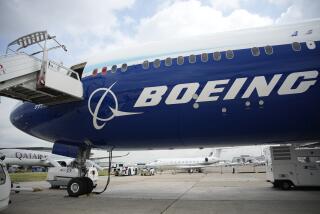A 40-Year-Long Dogfight for Aircraft Supremacy
- Share via
In the annals of titanic competitions between corporations, few during this century have been waged with the intensity or longevity as the one between Boeing Co. and Douglas Aircraft Co. for leadership of the commercial aircraft industry.
It pitted William Boeing against Donald Douglas, both of whom caught the fever for aviation early in the century and who would become the two driving forces in the production of ever more advanced aircraft.
Starting in 1920s, Boeing Co. and Douglas Aircraft fought for the next 40 years, repeatedly leapfrogging each other with innovations and marketing successes as the industry matured into one of critical national importance.
Although Douglas had thoroughly dominated Boeing at one point, the competition was won by Boeing by the late 1960s, when Douglas lacked the product line and resources to go head-to-head with the Seattle rival any longer. The Douglas facility in Long Beach was finally purchased by Boeing, along with the rest of McDonnell Douglas in 1997.
William Boeing began his career as an aviation industrialist after he was given a flight over Puget Sound by a barnstormer flying a seaplane. At the time, Boeing was helping to operate his family’s lucrative timber business in Seattle after dropping out of Yale University.
Not long after the flight, Boeing traveled to Southern California, where he learned to fly and purchased his own seaplane from Glenn Martin, the aircraft builder who was operating in a converted church in Santa Ana.
(Martin’s own company played another dramatic role in the aerospace industry and today is part of the Lockheed Martin Corp.)
*
Back in Seattle, Boeing began building his own seaplanes and by 1916 had incorporated his new company as Pacific Aero Products Co., which sold its first plane to the government of New Zealand for mail delivery. In 1917, the operation took on the name Boeing Airplane Co. By the mid-1920s, Boeing had assembled a business that was not only turning out innovative aircraft but also had laid the foundation for an air carrier that later became United Airlines.
Boeing formed a holding company, and then exchanged stock with the holding company to drive up prices--a then-legal investment similar to the capital manipulations that made J.P. Morgan renowned. The deals multiplied Boeing’s wealth into the stratosphere, but landed him before a Senate investigating committee. Angered by the probe, Boeing sold all his aviation stocks at age 52 and exited the industry. Ultimately, the company was forced to divest its holdings.
Boeing retired, but he left a skilled management team in place.
Under the Boeing name, during the 1930s, the company helped lead the way to single-wing planes with more efficient aerodynamic designs, retractable landing gear and better navigational aids. By the mobilization for World War II, the company was called on to build the B-17 Flying Fortress, one of the most important bombers of the Allied effort.
*
Douglas, meanwhile, caught the aviation bug from the Wright Brothers in 1908 during a U.S. Army flight demonstration. A brilliant engineer, Douglas graduated from MIT in two years with a degree in mechanical engineering. He worked for Martin until 1920 and then left to start his own aircraft company behind a barbershop in Los Angeles.
Douglas got one of his first big breaks from Jack Frye, Transworld Airlines chief, who in 1932 asked for a new, all-metal, three-engine aircraft that could carry 12 passengers. Douglas designed a plane that could carry 14 passengers at a higher speed with only two engines--sealing the deal.
That plane, the DC-1, laid the groundwork for Douglas to become the dominant builder of commercial aircraft. By 1934, Douglas was at work on the famous DC-3, the aircraft that would revolutionize air travel for the next 20 years and cement his place in aviation history.
The first DC-3 flight was Dec. 17, 1935, the 32nd anniversary of the Wright Brothers first flight. This reliable plane quickly caught on as airlines used DC-3s for their sleeper routes. The DC-3 had 21 to 28 passenger seats, a cruising speed of 180 mph and it could fly 1,000 miles without refueling.
During World War II the plane became the workhorse of the U.S. military (the military version was the C-47), and was used to tow gliders, drop paratroopers and haul cargo.
The DC-3 was more popular than Boeing’s rival 247 plane, and by World War II, 80% of the commercial aircraft in service were made by Douglas.
In all, Douglas built about 11,000 DC-3s and C-47s. Today, there are still about 500 DC-3s in use by cargo companies and the military in some Third World nations and South America.
But the competition turned against Douglas by the early 1950s. With his son helping run the company, Douglas hesitated in committing the resources to launch the DC-8 jetliner, giving Boeing a key lead in developing its 707 jetliner, which first flew in 1954. The 707’s success allowed Boeing to swiftly reverse leadership in the industry, outselling Douglas and grabbing the lead for good.
By the late 1960s, Douglas was struggling with the development of its DC-10, while Boeing was moving ahead with its highly profitable 747. With a weak financial condition and facing a bleak future, Donald Douglas reluctantly agreed to be bought out by James McDonnell, the brash newcomer who had built a military aircraft business in St. Louis.
More to Read
Inside the business of entertainment
The Wide Shot brings you news, analysis and insights on everything from streaming wars to production — and what it all means for the future.
You may occasionally receive promotional content from the Los Angeles Times.











